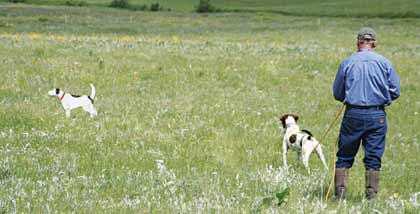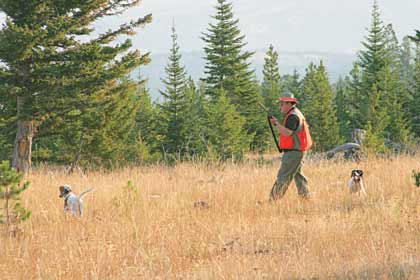Patience, the author admits, is not one of his Strongest attributes.
By Dave Carty
 Like all phases of training, steadying a young dog is something that shouldn't be rushed. |
I'm a pathetically Type A personality. I want everything done just so and immediately, if not sooner. After years of wrestling with this miserable curse, I've managed to nurture the Type B side of my persona, but "B" is still a long ways from "A" on my personal alphabet.
That has dearly cost me. Many years ago, impatient and frustrated with some pointless trifle, I slammed my fist through the rungs of a chair, which damn near broke my hand and improved the chair's attitude not a whit. Even today, I fantasize weekly about throwing my painfully slow and constantly balking computer off a 10-story rooftop. The first couple dogs I trained bore the brunt of that misplaced zeal: they were going to learn right now€¦or else.
That mindset has been, with few exceptions, a complete and utter failure. When it comes to training bird dogs, you may well be in charge of dictating the schedule of events, but your dog always gets the last word on the speed at which he learns them. Pounding your head against the wall won't hurry things along. As proof, I offer the dents in my living room wall as evidence.
The best way to get around any training-related roadblock is to stop before you make things worse, put the dog up for a day, and then try to figure out what went wrong. Sometimes, a break is all he needs, and he comes to the next session happy and willing to work. Other times, you have to go back two or three steps in the progression and start the training process all over again. Juno, one of two dogs I trained this past summer, was a case in point.
Juno was a happy-go-lucky Brittany, a stout little trooper eager to please and in love with birds. He was soft, so he would sulk from time to time if I pushed him too much for his liking, but for the most part he made it through the first half of my five-month training program in good shape.
All that changed when I introduced him to force breaking. That is not unusual, in my experience. I've yet to train a dog that enjoyed the force breaking process and some of them fight it violently, despite the fact that my methods (I use the traditional ear pinch) have become far less harsh over the years. Nonetheless, if a dog has it in him to put his paw down, force breaking is when he's going to do it.
As it turned out, happy-go-lucky Juno had a mind of his own. But rather than bolt or bite, Juno simply decided, apropos of nothing as far as I could see, that he wasn't going to pick up the dummies I threw for him anymore. He'd grant me one or two retrieves at the start of each session and then nada. I'd throw a dummy; he'd run past it and then stop and stare vacantly at the mountains as if trying to forget the whole unpleasant incident. An ear pinch would bring him around, but the next throw, next dummy, we'd go through the same song and dance all over again. At the point where he should have been getting over his aversion to retrieving and actually enjoying the process, he was becoming increasingly reluctant to retrieve at all.
When it finally dawned on me that our sessions weren't moving him forward, I knew what I had to do: go back two or three steps and start over again.
That was precisely what I did not want to do. It meant chucking several weeks of hard-won progress and giving up on the smooth, seamless transition from dummies to birds I'd envisioned. Worse, it meant adding an indeterminate amount of time to the whole process. Force-fetching is a long, muddy slog to begin with, and now I had to start all over? But there was no way around it; on the next session I'd return Juno to the bench.
And that's when my Irish luck revived. Juno had already been through bench work; within a day or two he was back on the ground picking up dummies I'd placed a few feet in front of him. Shortly after that he was in the yard retrieving thrown dummies, then dead birds, and finally flying, shot pigeons. It took only about a week and a half to get him back to where he'd been before and with minor lapses he's been an enthusiastic retriever of dummies and shot pigeons ever since.
So why had he balked? Had I pushed him too hard? Beats the hell out of me. But I do know this: for whatever reason, I was moving too fast. When I slowed down and gave him a breather, he responded and came along nicely--at his own deliberate pace. All I had to do was muster the patience to allow him to do that.
I'm not a believer in shortcuts and quick fixes. There's no way you can push a dog through 12 months of training in three months and not incur penalties for such rash optimism. There's a simple reason for this: The speed at which dogs are capable of learning and the speed at which they actually absorb the lesson are weeks and sometimes months apart.
Here's a simple example: Most dogs grasp the concept of the command "sit" in a few days, sometimes in a few lessons. But will that dog sit at a distance? When he's excited? When he's got any of a million other canine concerns occupying his mind? He knows what "sit" means, but it hasn't yet become a conditioned response, which takes€¦as long as it takes. But if we've got a bird season coming up, and our dog isn't quite where we want him, it's extremely tempting to exit the program--sit, come, whoa, whatever--the moment we think the dog has "got it." How do I know this? Ha.
Sticking with the game plan and having the patience to see it to fruition are what trains dogs, not demanding that training progress on an arbitrary timeline. And so it goes in the field. Most dogs are puppies (or puppy like) until they're around two, which is why most pointing dogs don't really hit their stride until they're three or four years of age. It is miles in the field, not necessarily the extent of the dog's training, that will get him there.
I'm certainly not suggesting that training take a back seat to hunting, only that a dog needs lots of hunting to fully absorb what he's learned in the yard and apply it effectively in the field. As most dogs mature, they settle down, are more receptive to doing things your way, and in general start figuring out that playing for your team isn't such a radical idea after all. In that regard, Hanna, my youngest setter, seems to be right on schedule.
Hanna was well schooled in the basics by the end of last summer: kennel, whoa, come, fetch, and steady to wing and shot. However, I chose not to work on her backing; at the time, she had enough on her plate. I was also hoping that she'd learn to back on her own. Many dogs do.
Not Hanna, though
. So about halfway through last season, I introduced her to backing a pointed dog in my yard and then began reinforcing it in the field.
 Reliably honoring another dog's point during an actual hunt will likely require quite a bit more practice and time. |
But Hanna wasn't thrilled about pointing the rear end of anything but Huns and grouse, and whenever she thought I wasn't looking, she'd steal another dog's point. I figured she'd come around eventually, so I kept correcting her whenever she refused to back, knowing that sooner or later the lesson would sink in. But the truth was, by the end of the season last fall she was no more interested in backing than she'd been when we started. She was one and a half years old.
She started this season at close to two and a half, and suddenly, backing is no longer a mental sticking point. After I ran her through a couple warm-up sessions in my yard, her backing had progressed nicely, if unevenly, with much less reluctance on her part to honor another dog. That I hadn't given up on her training is important, but equally important is that she's had another nine months or so to mature and absorb what she learned last summer. In dog years, she's skipped from the sixth grade to high school. When a young dog willingly begins to play by your rules, it's a sign that it is easing from adolescence into maturity.
Back to training. By the end of last summer's schooling, Hanna was steady to wing and shot, and she remained that way until my annual trip to Wisconsin at the end of October. Maybe it was the skittish grouse, maybe it was the phase of the moon, but she had no more set foot on Wisconsin's black and peaty soil than she abandoned the steadiness I'd painstakingly drilled into her like a worn out leash.
This was déjà vu all over again. As I would with Juno the following summer, I had a decision to make: to follow my natural inclination to pull out my hair, scream, and jump up and down; or to do what I knew was best for Hanna--step back, take stock of the situation and start over again.
That meant temporarily shelving my gun while I concentrated on getting Hanna to mind her manners. When she broke, I'd give her a nick, then pick her up and set her back in place. When she persisted in breaking, the intensity of the collar corrections went up. Finally, at last convinced that I meant business, she gave in.
One day she resumed holding at the shot as abruptly as she'd abandoned the practice a week earlier. Just in time, incidentally, for the arrival of my buddy Mike Bartz, who was duly impressed with her behavior. Wisely, I kept my mouth shut. My momma didn't raise no fool.
It takes time for any dog to adjust to a new situation. That is why (and undoubtedly to the regret of those who hire me to train their dogs) I harp endlessly on the importance of sticking to the dog's training program when it leaves my kennel and returns to theirs. Young dogs need constant guidance, it is true, but they also need an owner who understands that to finish his dog, he has to give it the time and free rein to incorporate what it knows but may not yet be ready to accept.
Pushing it too hard won't get the dog there sooner and may well set it back. Time, then, always belongs to the dog, but patience must always belong to you.






